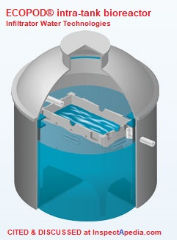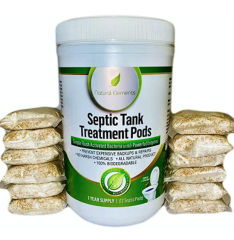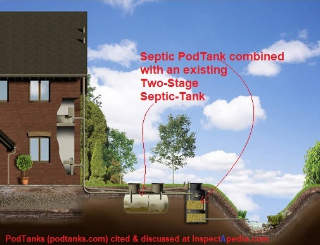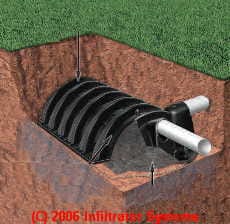 Septic Pod Systems
Septic Pod Systems
SepticPod tanks, treatment, filter media, life, sources, manuals
- POST a QUESTION or COMMENT about designs & types of septic pod systems for treating sewage and septic effluent.
This article describes pod septic systems that use one or more settlement tank and filter pods to treat sewage onsite.
InspectAPedia tolerates no conflicts of interest. We have no relationship with advertisers, products, or services discussed at this website.
- Daniel Friedman, Publisher/Editor/Author - See WHO ARE WE?
Pod Septic System Design & Operation
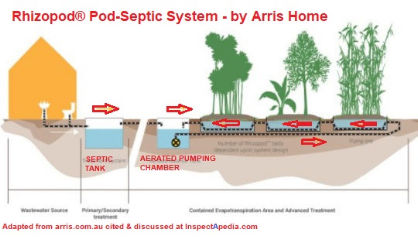 The terms Septic Pods, Filter-Pods, and similar names describe a variety of advanced sewage or wastewater onsite treatment systems suitable for single family homes as well as for larger installations and include at least those listed just below.
The terms Septic Pods, Filter-Pods, and similar names describe a variety of advanced sewage or wastewater onsite treatment systems suitable for single family homes as well as for larger installations and include at least those listed just below.
You will see that the phrase "pod" or "septic pod" is used in a variety of ways, but with the exception of septic tank "treatment pods" true septic pod systems all make use of an aerated chamber that distributes septic effluent through a filter media (man-made or plant-based).
The septic pod chamber itself may be of concrete, fiberglass, or plastic, and may be inserted in or external to a traditional septic tank.
Illustration: The Rhizopod® septic effluent treatment & disposal system from Arris Home, an Australian company cited below in this article.
[Click to enlarge any image]
- Recirculating plant-based septic pod systems
such as Arris Home's Rhizopod® System.
This design combines a septic tank or "primary treatment system" with an air-injected pumping chamber that circulates septic effluent through a cascaded system of shallow ponds into which various plants are hosted.
The plant root systems remove nitrites, nitrates, and also perform additional filtering and treatment of the septic effluent, recycling water through the system, disposing of effluent by evapo-transpiration (a "no-release" system design).
Other designs, "septic effluent volume reduction systems" ultimately relase some effluent into the surrounding soils. Some of these may use a dosing system for intermittent effluent release. - In-Septic-Tank Septic Filter Pods
such as those described by Crystal Tanks / PodTanks, that are installed inside the primary chamber of an existing septic tank. These pods combine air and a filter media to improve the level of treatment of wastewater in the septic tank. - Septic Treatment Pods
that combine a primary settling chamber with one or more additional chambers that include a septic filter media and air injection to treat septic effluent before it is discharged to surrounding soils.
These septic filter pods are small individual septic wastewater treatment units that typically are made up of a settlement section and a filter section. These may be comprised of two physically separate tanks or they may be combined in one physical unit.
Illustration: the Ecopod Infiltrator septic pod, an in-septic-tank bio-reactor from Infiltrator Water Technologies. This septic pod system increases the level of wastewater treatment.
- Add-On Septic Filter Pods
or FILTERPODs installed downstream from a traditional septic tank to further-treat septic effluent before it is discharged into surrounding soils. - Septic" tank treatment pods"
- packets of enzymes and / or bacteria claimed by the vendor to improve septic tank treatment efficacy. These packets or "pods" have nothing in common with the true septic pod systems described in the list above and are not a treatment that we recommend for conventional onsite septic tank and drainfield systems.
Illustration above: ECOPOD® series intra-tank bioreactor provided by Infiltrator Water Technologies, cited in detail below.
Unlike some pod septic systems described in this article, the Ecopod® can be inserted into an existing wastewater treatment tank to provide additional levels of wastewater treatment. [Permission requested 2022/03/07]
In a typical podtank septic system, sewage from the building first enters a settlement tank where some bacterial action performs partial processing of the waste. This tank may be a traditional septic tank or it may be a front-end chamber of a combination system that includes subsequent filtration and bioreactor stages.
Effluent from the settlement tank or settlement chamber then enters the second stage or tank or chamber that consists of a filter media.
Air and effluent passing through the filter media allow additional aerobic bacteria to further break-down pathogens in the wastewater. Air to boost the aerobic bacterial action may be provided by natural convection, by a solar powered fan, or by an conventional electric blower-fan.
Processed septic effluent is then discharged out of the treatment pod into surrounding soils.
Various Septic Pod system manufacturers may use different media, including peat or other specialized media.
Multiple septic pods may be ganged together or may be connected in series depending on the manufacturer's design or that specified by a septic design engineer.
Additional septic filter pods may be added to increase the total wastewater handling capacity of the system or to handle waste from individual occupancy units in a muti-unit complex such as at some condominiums.
The sewage settlement tank in septic pod systems must be cleaned regularly on an interval specified by the manufacturer, perhaps every 1-2 years.
The sewage effluent filter media will also require periodic replacement, perhaps every 8-10 years, again depending on just what filter media is used and on the septic pod manufacturer's specifications and, of course, on the level of use or volume of wastewater being treated.
Septic filterpods systems are an example of MEDIA FILTER SEPTIC SYSTEMS that we discuss more-extensively in that article where you will read that there quite a few varieties of packaged septic treatment systems.
Don't Confuse Septic Podtanks with "Septic Tank Treatment Pods"
Watch out: the article above describes a type of modular septic system that performs actual sewage treatment and prepares effluent for disposal into onsite soils.
Do not confuse pod type septic systems discussed above with "Septic Tank Treatment Pods" - small packages of "septic tank treatments" sold by some online vendors and that typically contain a mix of enzymes and bacterial cultures.
Such septic treatments are not required, and in some jurisdictions, because some septic treatment chemicals may harm the septic system, those may be prohibited by law, depending on where you live. Other harmless additives like enzymes are not necessary and are not recommended by independent septic authorities and experts. And none of these will restore a failed septic drainfield. See details
at SEPTIC TREATMENTS & CHEMICALS where you'll see that the key to septic system life is proper maintenance including pumping the septic tank on schedule.
Septic Pod System Suppliers
Above: use of a septic pod-tank connected to an existing septic tank in order to provide additional processing of clarified septic effluent flowing out of the septic tank.
- PodTanks,
[illustrated above] Unit 2
Bolton
York
Yorkshire
YO41 5QX
United Kingdom
Telephone: 01759 369915
Web: https://www.podtanks.com/ Email: sales@wte-ltd.co.uk or info@podtanks.com
CrystalTank, below, appears to be the same company - Ed. - CrystalTanks, FilterPod, Tel: Europe: +353 21 234 8049 Canada and US: +1 819 598 7153 Email: info@clearpodwater.com Web: http://www.clearpodwater.com/clearpod-system/
The company describes this non-electric sewage treatment plant and septic tank conversion kit and an in-tank treatment system that is inserted into an existing septic tank to improve the level of sewage treatment.
The treatment pod is designed to work for about a year before servicing is required, and is expected to last for ten years with annual servicing.
Excerpts:
The system can be easily dropped into the first chamber of a typical 2-chambered septic system. The system has a maximum diameter of18” allowing for easy integration with current septic systems which have opening ports ranging from (20 – 24”).
The ClearPod™ air pump will require a constant supply of air to successfully deliver oxygen to the septic system. In the case of heavy snow fall you will have to either momentarily turn off your system or simply cover the system and allow air delivery to the pump.
- Arris Home, Head Office – Queensland
44 Wentworth Terrace
Rockhampton QLD 4700
Australia, Tel: 08 8313 6706 Email: water@arris.com.au
Rhizopod® System Technology [Arris PRODUCT CATALOG], Web: https://www.arris.com.au/water/products/rhizopod-system-technology/
Excerpt:
The Rhizopod® system is a ‘no-release’ evapotranspiration channel used to disperse on-site and decentralised treated wastewater into the atmosphere. It has been developed for use on difficult sites where soil types, set-back distances, or available footprint has meant that other forms on water dispersal are not practical. Pre-treatment is provided through septic tanks and/or package treatment units.
The Rhizopod® channels are designed to resemble a raised garden bed. Treated water is pumped through a series of pods planted with a variety of plants.
Any water not used for evapotranspiration is stored in a balance tank and recirculated through the pods until used. The recirculating nature of the technology and the holding tank have resulted in a relatively small footprint for the Rhizopod® system.
The Rhizopod® technology has been installed and operating since 1998.
The Rhizopod® is available in either concrete or plastic pods. Both types of pods have been certified by SAI Global as compliant with AS/NZ 1546.1: 2008. Please note, in South Australia only the concrete pod is available. - Infiltrator Systems, Inc.provides chamber products, 4 Business Park Road
P.O. Box 768
Old Saybrook, CT 06475
USA Tel: 800-718-2754 .
Website: https://www.infiltratorwater.com/delta-treatment-systems/ecopod/
Infiltrator has \offices around the world, including Algeria, Belgium, Canada, Chile, Columbia, France, Mexico, Morocco, New Zealand, Puerto Rico, Spain, and the United States.
Infiltrator Systems provides state specific design manuals for no-rock chamber systems and other wastewater treatment systems for specific states in the U.S.
INFILTRATOR PRODUCT CATALOG [PDF] retrieved 2022/03/07 original source cited above. - Infiltrator Water Technologies, ECOPOD Series for advanced wastewater treatment, retrieved 2022/03/07 original source: https://www.infiltratorwater.com/delta-treatment-systems/ecopod/
[Illustrated above on this page]
Excerpts:
ECOPOD® series is an intra-tank bioreactor that can be inserted into an average sized onsite wastewater treatment tank or vault (round or rectangular).
ECOPOD® series utilizes a fixed-film process which is characteristically stable, reliable and robust. Fixed-film is a preferred treatment process in many areas for onsite wastewater treatment systems.
...
Continue reading at MEDIA FILTER SEPTIC SYSTEMS, or select a topic from the closely-related articles below, or see the complete ARTICLE INDEX.
Or see these
Recommended Articles
- AEROBIC SEPTIC SYSTEMS, ATUs
- GRAVELLESS SEPTIC SYSTEMS
- LAGOON SEPTIC SYSTEMS
- MEDIA FILTER SEPTIC SYSTEMS
- PEAT FILTERED SEPTIC SYSTEMS
- POD SEPTIC SYSTEMS
- SEPTIC SYSTEM DESIGN ALTERNATIVES - home
- SEPTIC TREATMENTS & CHEMICALS
- SEWAGE TREATMENT PLANTS, RESIDENTIAL - Packaged onsite septic systems
- WETLAND SEPTIC SYSTEMS
Suggested citation for this web page
POD SEPTIC SYSTEMS at InspectApedia.com - online encyclopedia of building & environmental inspection, testing, diagnosis, repair, & problem prevention advice.
Or see this
INDEX to RELATED ARTICLES: ARTICLE INDEX to SEPTIC SYSTEMS
Or use the SEARCH BOX found below to Ask a Question or Search InspectApedia
Ask a Question or Search InspectApedia
Try the search box just below, or if you prefer, post a question or comment in the Comments box below and we will respond promptly.
Search the InspectApedia website
Note: appearance of your Comment below may be delayed: if your comment contains an image, photograph, web link, or text that looks to the software as if it might be a web link, your posting will appear after it has been approved by a moderator. Apologies for the delay.
Only one image can be added per comment but you can post as many comments, and therefore images, as you like.
You will not receive a notification when a response to your question has been posted.
Please bookmark this page to make it easy for you to check back for our response.
IF above you see "Comment Form is loading comments..." then COMMENT BOX - countable.ca / bawkbox.com IS NOT WORKING.
In any case you are welcome to send an email directly to us at InspectApedia.com at editor@inspectApedia.com
We'll reply to you directly. Please help us help you by noting, in your email, the URL of the InspectApedia page where you wanted to comment.
Citations & References
In addition to any citations in the article above, a full list is available on request.
- Our recommended books about building & mechanical systems design, inspection, problem diagnosis, and repair, and about indoor environment and IAQ testing, diagnosis, and cleanup are at the InspectAPedia Bookstore. Also see our Book Reviews - InspectAPedia.
- In addition to citations & references found in this article, see the research citations given at the end of the related articles found at our suggested
CONTINUE READING or RECOMMENDED ARTICLES.
- Carson, Dunlop & Associates Ltd., 120 Carlton Street Suite 407, Toronto ON M5A 4K2. Tel: (416) 964-9415 1-800-268-7070 Email: info@carsondunlop.com. Alan Carson is a past president of ASHI, the American Society of Home Inspectors.
Thanks to Alan Carson and Bob Dunlop, for permission for InspectAPedia to use text excerpts from The HOME REFERENCE BOOK - the Encyclopedia of Homes and to use illustrations from The ILLUSTRATED HOME .
Carson Dunlop Associates provides extensive home inspection education and report writing material. In gratitude we provide links to tsome Carson Dunlop Associates products and services.


